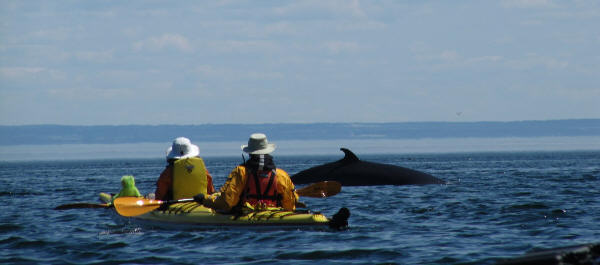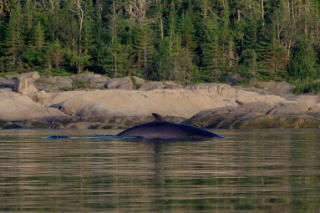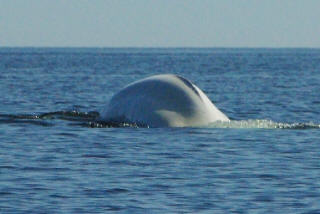by Šárka Lhoták
I arrived at the Paradis Marin campground, parked the car and walked to the office to register. As I looked over the wide waters of the St.Lawrence estuary, I saw two white backs that slowly dove under water. Belugas! It couldn’t have been anything else, white like this! So they are really here!
Not even 200 metres from the launch ramp we met our first large whale, a humpback. We watched it go up and down and flip its tail. There were many people in kayaks and zodiacs chasing it. We saw few more whales on our little afternoon paddle. I had a feeling the whales must be poking fun at us, navigating safely quite close between all the boats. The prize they were after must have been worth the trouble. This is an area (between Tadoussac and Bergeronnes) of very deep and cold water, and it mixes with a strong deep current from the Saguenay fjord stirring up plankton, attracting fish and whales.
On Saturday morning Paul’s friends Luc and Ghyslaine joined us. We drove to L’Anse-de-Roche, a little village with a marina on the north shore of the Saguenay fjord, and another difficult launch from a steep concrete ramp. From here we paddled upstream past steep cliffs to Baie Sainte-Marguerite. It is an estuary with large mudflats and known for belugas. But we were out of luck; they hadn’t seen belugas here for the past 14 days. The scenery was breathtaking and the weather perfect. May and I went for a swim, the water was cold, just as we like it. A large barge was working its way upstream with a load of bauxite from South America to the smelter in Saguenay. I guess the abundance of hydroelectric power makes it worth to bring bauxite all the way here. Many high voltage power lines straddle the fjord supplying power to the south. The fjord was about two-kilomtres wide here. We crossed it diagonally and then paddled back again to L’Anse-de-Roche; a nice 18-20 kilometre paddle. We finished the day with cold beer in Bar Gibard on the waterfront in Tadoussac and a nice dinner afterwards.
Next morning Luc and Ghyslaine again joined us in the Paradis Marin campground for a paddle downstream on the St. Lawrence River. We saw a number of whales including belugas along the way. You hear them first, a big “whoosh,” sometimes very close. You start frantically looking around and try to get a picture. The kayak is rocking, the camera reaction is slow so most shots end up showing just water or sky. There were actually many more whales there than we have in our pictures! Belugas were the easiest to photograph as they were undulating up and down with predictability for long periods of time. The St. Lawrence is a very busy shipping highway with big colourful freighters always in view. However, we paddled close to shore where most of the whales are and in no danger from the commercial traffic. After an exciting paddle we arrived in a beautiful quiet Anse a la Barque where we had lunch and waited lazily for the tide to turn to take us back upstream.
The tides are around 3 metres on the St. Lawrence and the Saguenay which makes for a lot of backbreaking carrying and dragging the boats in and out. A cart can be very useful. Back at the campground we again had to load kayaks on cars. Though the campground looked like a big Rendezvous, it was not that idyllic and you cannot leave the boat near the water. We were told that kayaks were frequently stolen. There were some racks (though not nearly enough of them) for storing kayaks close to the ramp but apparently it was not safe to leave a boat there without locking it.
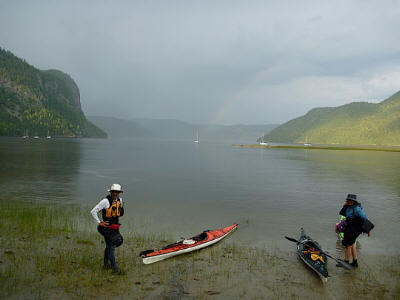
Next morning we paddled downstream towards L’Anse Saint Jean. Again, in the morning the conditions were easy but in the early afternoon a thunderstorm came. This weather pattern was repeated daily: nice morning, a thunderstorm in the afternoon, showers and rain through the night. The nights were cold, I was happy to have my down-filled sleeping bag. We shared our beautiful campsite (Anse de Tabatiere) with a young couple who were paddling the whole length of the fjord, from Sainte-Rose du Nord to Tadoussac. They were going to take a bus back along the north shore road. Another group we met were Americans from New Hampshire. They were paddling from Baie Eternite to Tadoussac and using the Park’s service to shuttle their car.
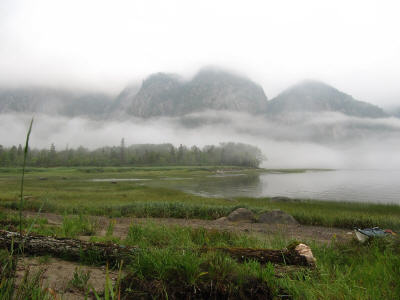
We were hoping to spend one more night on the fjord. But listening to the weather forecast it was obvious that a major change was coming next day, temperatures plunging from the comfortable mid twenties to highs of 13 and lows of 8, with winds of 20-25 knots. We had better get out of there! But it could not spoil our last day. We paddled to L’Anse Saint Jean, a nice bay with a typical village with a church spire, fields and meadows with cows, a welcome change after the stern wilderness of the fjord. Then we turned back and paddled to Baie Eternite. Conditions were perfect, the sun was shining and we had not a worry on our minds. I got into that perfect paddling rhythm when you feel at one with the paddle and the kayak is just gliding effortlessly along. We wanted to have one more swim before getting back to the muddy Baie Eternite so we paddled close to the shore to find a landing spot. Suddenly I saw something white moving in an unusual slithering motion over a rock ledge just above water. Paddling closer I realized it was a seal puppy! It looked somewhat concerned glancing back and forth between my and May’s boats as I was taking pictures. Soon after, we found a tiny spot barely large enough to land two boats there. Before we could jump in the water, the mother seal appeared. She swam furiously around and at one point jumped fully out of the water and plunged with a big splash back in an attempt to scare us away.
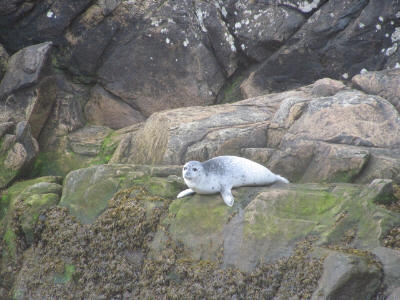
Thank you Peter for organizing it, and Paul for showing us around. A la prochaine!

